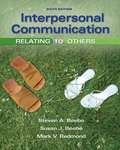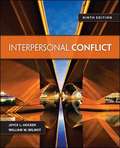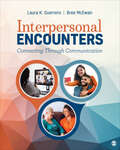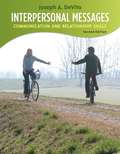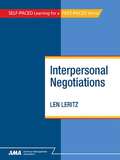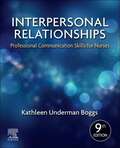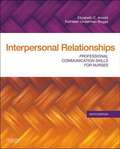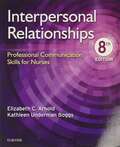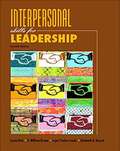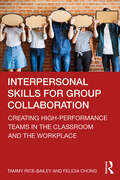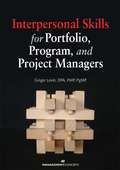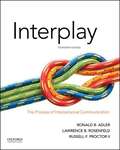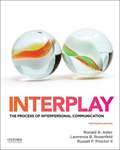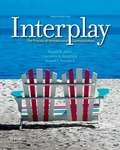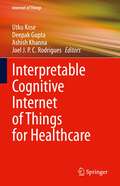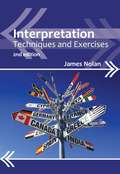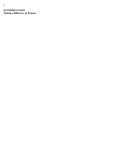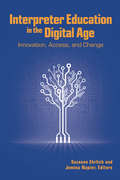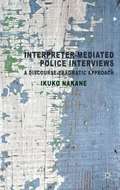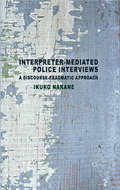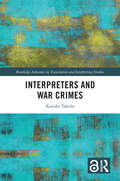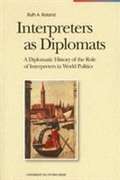- Table View
- List View
Interpersonal Communication: Relating to Others
by Susan J. Beebe Steven A. Beebe Mark V. RedmondRecognized for its focus on being "other-oriented" - a focal point that highlights the importance interpersonal interactions -Interpersonal Communication: Relating to Others enhances communication competence in a variety of interpersonal relationships and interpersonal contexts. This sixth edition emphasizes the expanding role of technology in interpersonal communication and the implication of its use in our daily relationships and communication with others. Relating to Others also offers exceptional coverage of cultural diversity, to help readers understand and adapt to these differences while learning how to establish common links with other individuals enabling them to build and strengthen relationships in their everyday lives.
Interpersonal Conflict
by William W. Wilmot Joyce L. HockerInterpersonal Conflict explains the key dynamics of personal conflicts that we all face. Written for courses such as Communication and Conflict, Interpersonal Conflict, Conflict Management, Conflict and Negotiation, and Conflict in Personal Relationships, this textbook examines the central principles of effective conflict management in a wide variety of contexts--whether at home or on the job. Its combination of up-to-date research and examples gives students a theoretical and practical foundation in conflict management. Instructors and students can now access their course content through the Connect digital learning platform by purchasing either standalone Connect access or a bundle of print and Connect access. McGraw-Hill Connect® is a subscription-based learning service accessible online through your personal computer or tablet. Choose this option if your instructor will require Connect to be used in the course. Your subscription to Connect includes the following: * SmartBook® - an adaptive digital version of the course textbook that personalizes your reading experience based on how well you are learning the content. * Access to your instructor's homework assignments, quizzes, syllabus, notes, reminders, and other important files for the course. * Progress dashboards that quickly show how you are performing on your assignments and tips for improvement. * The option to purchase (for a small fee) a print version of the book. This binder-ready, loose-leaf version includes free shipping. Complete system requirements to use Connect can be found here: http://www. mheducation. com/highered/platforms/connect/training-support-students. html
Interpersonal Encounters: Connecting Through Communication
by Laura K. Guerrero Bree McEwanWith a practical and innovative approach, Interpersonal Encounters: Connecting through Communication shows students how interpersonal communication skills can be best used to accomplish everyday relationship goals. Guided by current interpersonal research from diverse authors and study participants, Laura K. Guerrero and Bree McEwan focus on the functions of interpersonal communication in our everyday lives and demonstrate how concepts, theories, and contemporary research apply to building, maintaining, and ending relationships. The book’s unique structure prepares students to become better communicators in their personal and professional lives. This title is accompanied by a complete teaching and learning package. Digital Option / Courseware SAGE Vantage is an intuitive digital platform that delivers this text’s content and course materials in a learning experience that offers auto-graded assignments and interactive multimedia tools, all carefully designed to ignite student engagement and drive critical thinking. Built with you and your students in mind, it offers simple course set-up and enables students to better prepare for class. Assignable Video with Assessment Assignable video (available with SAGE Vantage) is tied to learning objectives and curated exclusively for this text to bring concepts to life. LMS Cartridge: Import this title’s instructor resources into your school’s learning management system (LMS) and save time. Don’t use an LMS? You can still access all of the same online resources for this title via the password-protected Instructor Resource Site.
Interpersonal Encounters: Connecting Through Communication
by Laura K. Guerrero Bree McEwanWith a practical and innovative approach, Interpersonal Encounters: Connecting through Communication shows students how interpersonal communication skills can be best used to accomplish everyday relationship goals. Guided by current interpersonal research from diverse authors and study participants, Laura K. Guerrero and Bree McEwan focus on the functions of interpersonal communication in our everyday lives and demonstrate how concepts, theories, and contemporary research apply to building, maintaining, and ending relationships. The book’s unique structure prepares students to become better communicators in their personal and professional lives. This title is accompanied by a complete teaching and learning package. Digital Option / Courseware SAGE Vantage is an intuitive digital platform that delivers this text’s content and course materials in a learning experience that offers auto-graded assignments and interactive multimedia tools, all carefully designed to ignite student engagement and drive critical thinking. Built with you and your students in mind, it offers simple course set-up and enables students to better prepare for class. Assignable Video with Assessment Assignable video (available with SAGE Vantage) is tied to learning objectives and curated exclusively for this text to bring concepts to life. LMS Cartridge: Import this title’s instructor resources into your school’s learning management system (LMS) and save time. Don’t use an LMS? You can still access all of the same online resources for this title via the password-protected Instructor Resource Site.
Interpersonal Messages: Communication and Relationship Skills (2nd edition)
by Joseph A. DevitoUpdated in a new 2nd edition, Interpersonal Messages stresses the importance of politeness, cultural awareness and ethical principles within daily interpersonal interactions by engaging students with its lively and accessible insight to interpersonal skill development. By creating a foundation for the reader,Interpersonal Messages gives room to understand the concepts of interpersonal communication and to develop the skills necessary to apply what they've learned. With a focus on skill-building, this book helps the reader to understand how to master interpersonal communication and relationship skills.
Interpersonal Negotiations Breaking Down the Barriers
by Len LeritzFinally…a negotiation framework that encourages a positive outcome for both parties. This book takes the "win/win" concept a step further to make negotiating a more gratifying experience—even if you don’t get exactly what you want. Interpersonal Negotiations: Breaking Down the Barriers builds on mutual understanding and respect for each other's needs and provides a proven framework for fulfilling them. You’ll discover the secrets that can help turn an adversary into an advocate. You will learn how to: • Ensure a safe, fair, and effective negotiation process • Direct the negotiation process to create mutual understanding and acceptance • Recognize and understand your own needs and those of the other person • Make it easy for others to understand your needs • Be creative and persistent to address and resolve blocks to successful negotiation • Assess the other person's behavioral and emotional responses • Acknowledge your own and the other person's perceptions and beliefs • Avoid getting mired in the process
Interpersonal Relationships: Professional Communication Skills For Nurses
by Kathleen Underman BoggsMaster the skills you need to communicate effectively in the health care setting! Interpersonal Relationships: Professional Communication Skills for Nurses, 9th Edition shows how you can interact with patients, families, and the health care team in ways that are professional, honest, empathetic, and knowledgeable. A clear guide to essential competencies, this book covers relationship skills, health promotion, patients with special communication needs, and interprofessional communication. Case examples make it easier to apply communication theories to real-life practice. New to this edition are Next Generation NCLEX® (NGN)-style case studies and a new chapter on managing personal stress. Written by noted educator Kathleen Underman Boggs, this reference is a two-time winner of the American Journal of Nursing Book of the Year award.
Interpersonal Relationships: Professional Communication Skills for Nurses
by Rn Kathleen Underman Boggs Elizabeth C. Arnold Pmhcns-Bc Fnp-CsEffective communication with clients, families, and professional colleagues starts here! With Interpersonal Relationships: Professional Communication Skills for Nurses, 7th Edition, you'll see how good communication skills can lead to achieving treatment goals in health care. Clear guidelines show how you can enhance the nurse-client relationship through proven communication strategies as well as principles drawn from nursing, psychology, and related theoretical frameworks. And you'll see how to apply theory to real-life practice with case studies, interactive exercises, and evidence-based practice studies. A two-time winner of the AJN Book of the Year award, this book is updated to emphasize interdisciplinary communication and QSEN competencies. From expert nursing educators Elizabeth Arnold and Kathleen Underman Boggs, this comprehensive, market-leading text is unmatched for helping nurses develop effective communication skills! Interactive exercises offer the opportunity to practice, observe, and critically evaluate your professional communication skills in a safe learning environment. Practical guidelines describe how to modify communications strategies for various populations and situations including children, the elderly, end of life, clients with special needs, health teaching, stress, crisis, and professional colleagues. Case examples help you develop empathy for clients' perspectives and needs. Nursing, behavioral, developmental, family, and communication theories provide an essential foundation and a theoretical perspective for effective communication. Learning objectives, chapter overviews, and a detailed glossary focus your study and help you absorb and retain key content. NEW! A greater emphasis on communication, interdisciplinary theory, and interprofessionalism includes a focus on the nursing paradigm, nursing discipline, and ways of knowing. NEW! Focus on QSEN competencies reflects current thinking on technology, safety, and evidence-based practice, especially as they relate to communication in nursing. NEW! Discussion questions at the end of each chapter encourage critical thinking. NEW! Clarity and Safety in Communication chapter addresses topics such as huddles, rounds, handoffs, SBAR, and other forms of communication in health care.
Interpersonal Relationships: Professional Communication Skills for Nurses
by Kathleen Underman Boggs Elizabeth C. ArnoldInterpersonal Relationships: Professional Communication Skills for Nurses, 8th Edition helps you to develop skills in communicating effectively with clients, families, and colleagues in order to achieve treatment goals in health care. Using clear, practical guidelines, it shows how to enhance the nurse-client relationship through proven communication strategies as well as principles drawn from nursing, psychology, and related theoretical frameworks. The 8th edition includes engaging new content relating to current issues, while also emphasizing interdisciplinary communication and QSEN competencies. You will learn how to apply theory to real-life practice through case studies, interactive exercises, and evidence-based practice studies.
Interpersonal Skills For Leadership
by William Brown Susan Fritz Joyce Lunde Elizabeth BansetFor courses in interpersonal skills, communication, leadership development, or service learning in Business Studies departments. This practical resource provides an introduction to interpersonal skills theories which are reinforced through experiential activities. Coverage focuses on the development of the basic interpersonal skills necessary to command one's own life, relate well to other people and to lead others in positive directions.
Interpersonal Skills for Group Collaboration: Creating High-Performance Teams in the Classroom and the Workplace
by Tammy Rice-Bailey Felicia ChongThis lively and engaging text introduces readers to the core interpersonal and organizational skills needed to effectively collaborate on group projects in the classroom and the workplace. Group projects are critical in preparing students for the realities of today’s workplace, but many college students despise group work—often because they have not been prepared with the necessary skills to effectively collaborate. This guide teaches core collaboration skills such as active listening, interviewing, empathy, and conflict resolution. It examines the research and theory behind these skills, and provides tangible ways to practice these skills both alone and in groups. This guide can be used a supplementary text for any courses involving group projects, and will also be of interest to professionals in communication, business, and many other fields.
Interpersonal Skills for Portfolio, Program, and Project Managers
by Ginger Levin DPA, PMP, PgMPImprove Your Interpersonal Skills to Achieve Greater Management Success!Any formula for management success must include a high level of interpersonal skills. The growing complexity of organizational portfolios, programs, and projects, as well as the increasing number and geographic dispersion of stakeholders and employees, makes a manager's interpersonal skills critical. The frequency and variety of interpersonal interactions and the pressure to perform multiple leadership roles successfully while ensuring customer satisfaction have never been greater.Interpersonal Skills for Portfolio, Program, and Project Managers offers practical and proven tools and methods you can use to develop your interpersonal skills and meet the challenges of today's competitive professional environment.Develop the interpersonal skills you need to:• Build effective, high-performing teams• Work efficiently with virtual teams• Develop approaches to build and maintain relationships with stakeholders at all levels• Handle stress and deal with unexpected critical incidents• Motivate your teamWhatever your level of experience, you will find these practical and proven methods to be the best formula for improving your interpersonal skills-and enhancing your management success.The chapters include discussion questions, making this a perfect text for use in academic or workshop settings.
Interplay: The Process Of Interpersonal Communication
by Ronald B. Adler Lawrence B. Rosenfeld Russell F. Proctor IIPacked with contemporary examples, cutting-edge research, and accessible writing, Interplay helps students apply insights from scholarship to everyday life. While highlighting the breadth of interpersonal communication research and theory, Interplay also gives students the practical skills they need to improve their own relationships. This new edition of Interplay is the most contemporary text available. The first chapter highlights masspersonal and multimodal communication, setting the stage for integration of social media and mediated communication throughout the book. Expanded discussions of intersectionality, code-switching, disability studies, and gender and language emphasize the role of culture and identity in shaping interactions. Every chapter is full of updated features, including"Focus on Research" and "Dark Side of Communication" boxes. Students can explore and apply concepts with the viral videos and discussion questions in the new "Watch and Discuss" activities that appear in every chapter. Oxford's easy-to-use Dashboard Online Assessment system now features an integrated eBook, video clips, and interactive assignments-everything you and your students need, all in one place.
Interplay: The Process of Interpersonal Communication
by Ronald B. Adler Lawrence B. Rosenfeld Russell F. Proctor IIWith its unique blend of compelling topics and rich pedagogy, Interplay: The Process of Interpersonal Communication, Fifteenth Edition, offers a perfect balance of research and application to help students understand and improve their own relationships. No other book prepares students better to start improving their relationships beginning with the first day of class.
Interplay: The Process of Interpersonal Communication
by Ronald Adler Lawrence Rosenfeld Russell ProctorWith its unique blend of compelling topics and rich pedagogy, the thirteenth edition of Interplay: The Process of Interpersonal Communication offers a perfect balance of theory and application to help students understand and improve their own relationships. Interplay's inviting visual format and rich pedagogy continue to make this text the market leader in Interpersonal Communication.
Interplay: The Process of Interpersonal Communication (12th Edition)
by Ronald B. Adler Russell F. Proctor Lawrence B. RosenfeldWith its unique blend of compelling topics and rich pedagogy, the twelfth edition of Interplay shows how scholarship, research, and theory can introduce students to communication and help them understand their own relationships in everyday life. New to this edition:The most extensive use of current research of any interpersonal book on the market: 1,512 total sources, of which 514 are new (34% more than the previous edition)Chapter 2, "Interpersonal Communication in a Changing World: Culture and Social Networking," includes the latest coverage of social media's impact on interpersonal relationships. Chapter 12, "Interpersonal Contexts" includes a new discussion of communication in friendships and updated sections on communication in intimate relationships and family"At Work" boxes in every chapter help readers apply scholarship to their careers"Media Clips" now use both television and films to illustrate communication concepts.
Interpretable Cognitive Internet of Things for Healthcare (Internet of Things)
by Deepak Gupta Ashish Khanna Utku Kose Joel J. P. C. RodriguesThis book presents research on how interpretable cognitive IoT can work to help with the massive amount of data in the healthcare industry. The authors give importance to IoT systems with intense machine learning features; this ensures the scope corresponds to use of cognitive IoT for understanding, reasoning, and learning from medical data. The authors discuss the interpretability of an intelligent system and its trustworthiness as a smart tool in the context of massive healthcare applications. As a whole, book combines three important topics: massive data, cognitive IoT, and interpretability. Topics include health data analytics for cognitive IoT, usability evaluation of cognitive IoT for healthcare, interpretable cognitive IoT for health robotics, and wearables in the context of IoT for healthcare. The book acts as a useful reference work for a wide audience including academicians, scientists, students, and professionals.
Interpretation
by James NolanIn recent decades the explosive growth of globalization and regional integration has fuelled parallel growth in multilingual conferences. Although conference interpreting has come of age as a profession, interpreter training programs have had varied success, pointing to the need for an instructional manual which covers the subject comprehensively. This book seeks to fill that need by providing a structured syllabus and an overview of interpretation accompanied by exercises in various aspects of the art. It is meant to serve as a practical guide for interpreters and as a complement to interpreter training programs in the classroom and online, particularly those for students preparing for conference interpreting in international governmental and business settings. This expanded second edition includes additional exercises and provides direct links to a variety of web-based resources and practice speeches, also including additional language combinations.
Interpretation: Making A Difference On Purpose
by Sam H. HamIn the new edition of the international bestseller Environmental Interpretation, Sam H. Ham captures what has changed in our understanding of interpretation during the past two decades. Ham draws on recent advances in communication research to unveil a fresh and invigorating perspective that will lead interpreters to new and insightful pathways for making a difference on purpose through their work.
Interpreter Education in the Digital Age: Innovation, Access, and Change
by Jemina Napier Suzanne EhrlichThis collection brings together innovative research and approaches for blended learning using digital technology in interpreter education for signed and spoken languages. Volume editors Suzanne Ehrlich and Jemina Napier call upon the expertise of 21 experts, including themselves, to report on the current technology used to provide digital enhancements to interpreter education in Australia, New Zealand, Brazil, Belgium, the United Kingdom, and the United States. Divided into three parts, Innovation, Change, and Community Engagement, this study focuses on the technology itself, rather than how technology enhances curriculum, delivery, or resources. Initiatives described in this collection range from the implementation of on-demand interpreting using iPad technology to create personalized, small-group, multidimensional models suited to digital media for 160 languages; introducing students to interpreting in a 3D world through an IVY virtual environment; applying gaming principles to interpreter education; assessing the amenability of the digital pen in the hybrid mode of interpreting; developing multimedia content for both open access and structured interpreter education environments; to preparing interpreting students for interactions in social media forums, and more. Interpreter Education in the Digital Age provides a context for the application of technologies in interpreter education from an international viewpoint across languages and modalities.
Interpreter Training in Conflict and Post-Conflict Scenarios
by Marija Todorova Lucía Ruiz RosendoThe role of interpreters in conflict situations is of increasing real world importance. There are ethical, cultural and professional issues that have yet to be explored and there is a need for specialised training that addresses the specific contexts in which interpreters perform their duties, considering the situated nature of interpreting in these contexts. This volume is structured around interpreter training in different contexts of conflict and post-conflict, from military operations and international tribunals to asylum-seeking and refugee, humanitarian and human rights missions. Themes covered include risk management and communication, ethics and professional demeanour, language technology and its use, intercultural mediation, training in specific contexts, such as conflict resolution and negotiation, and working with trauma. Chapters are authored by experts from around the world with a range of different profiles: military personnel, scholars, the staff of international organisations, and representatives from refugee and asylum-seeker-assisting institutions. Interpreter Training in Conflict and Post-Conflict Scenarios is key reading both for students and scholars researching interpreting in conflict zones and conflict-related scenarios and for practising and trainee interpreters and mediators working for international organisations and the military.
Interpreter-mediated Police Interviews
by Ikuko NakaneThis book shows how the participation of interpreters as mediators changes the dynamics of police interviews, particularly with regard to power struggles and competing versions of events. Employing a range of approaches including conversation analysis, interactional sociolinguistics and legal narrative theory, Interpreter-mediated Police Interviews provides a detailed study of the impact of interpreter mediation on this area of the justice system. It reveals how turn-by-turn decisions of communication by all three participants, including the interpreter, affect the trajectory of the institutional discourse. By providing a better understanding of police interview discourse and exploring the practical implications of interpreter participation, this book contributes to the improvement of interpreter-mediated investigative interviews and will be of great interest to legal professionals as well as interpreters and their trainers.
Interpreter-mediated Police Interviews: A Discourse-Pragmatic Approach
by I. NakaneThis book shows how participation of interpreters as mediators changes the dynamics of police interviews, particularly with regard to power struggles and competing versions of events. The analysis of interaction offers insights into language in the legal process.
Interpreters and War Crimes (Routledge Advances in Translation and Interpreting Studies)
by Kayoko TakedaTaking an interdisciplinary approach, this book raises new questions and provides different perspectives on the roles, responsibilities, ethics and protection of interpreters in war while investigating the substance and agents of Japanese war crimes and legal aspects of interpreters’ taking part in war crimes. Informed by studies on interpreter ethics in conflict, historical studies of Japanese war crimes and legal discussion on individual liability in war crimes, Takeda provides a detailed description and analysis of the 39 interpreter defendants and interpreters as witnesses of war crimes at British military trials against the Japanese in the aftermath of the Pacific War, and tackles ethical and legal issues of various risks faced by interpreters in violent conflict. The book first discusses the backgrounds, recruitment and wartime activities of the accused interpreters at British military trials in addition to the charges they faced, the defence arguments and the verdicts they received at the trials, with attention to why so many of the accused were Taiwanese and foreign-born Japanese. Takeda provides a contextualized discussion, focusing on the Japanese military’s specific linguistic needs in its occupied areas in Southeast Asia and the attributes of interpreters who could meet such needs. In the theoretical examination of the issues that emerge, the focus is placed on interpreters’ proximity to danger, visibility and perceived authorship of speech, legal responsibility in war crimes and ethical issues in testifying as eyewitnesses of criminal acts in violent hostilities. Takeda critically examines prior literature on the roles of interpreters in conflict and ethical concerns such as interpreter neutrality and confidentiality, drawing on legal discussion of the ineffectiveness of the superior orders defence and modes of individual liability in war crimes. The book seeks to promote intersectoral discussion on how interpreters can be protected from exposure to manifestly unlawful acts such as torture.
Interpreters as Diplomats: A Diplomatic History of the Role of Interpreters in World Politics
by Ruth A. RolandThis book looks at the role played throughout history by translators and interpreters in international relations. It considers how political linguistics function and have functioned throughout history.
